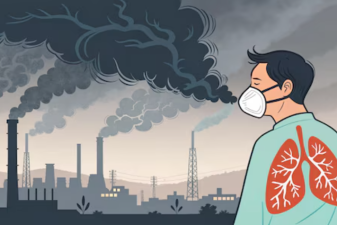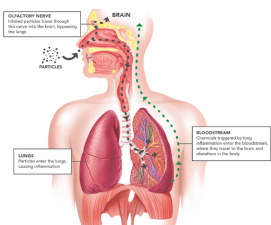Air Quality Warnings Linked to Respiratory Illnesses
The respiratory system is a vital part of our bodies, responsible for supplying oxygen, removing carbon dioxide, and maintaining vital functions. Environmental pollution has become a serious global problem, and air pollution is one of the most prominent. However, environmental factors, particularly air quality, have a profound impact on respiratory health.
The respiratory system is a vital part of our bodies, responsible for supplying oxygen, removing carbon dioxide, and maintaining vital functions. Environmental pollution has become a serious global problem, and air pollution is one of the most prominent. However, environmental factors, particularly air quality, have a profound impact on respiratory health.
Effects of Pollutants on the Lungs:
Particulate matter: Tiny particles enter the alveoli, hindering gas exchange and causing symptoms such as shortness of breath and wheezing.
Ozone: High concentrations of ozone irritate the respiratory tract, causing airway inflammation and worsening asthma symptoms.
Sulfur dioxide: Upon entering the respiratory tract, it forms sulfuric acid, causing airway irritation and triggering an inflammatory response.

Relationship between Air Pollution and Respiratory Diseases
- Acute Respiratory Infections
Particulate matter and harmful gases in air pollution can irritate the respiratory mucosa, weakening the respiratory defenses, making people more susceptible to respiratory viruses and bacteria, leading to acute respiratory infections.
- Chronic Respiratory Diseases
Long-term exposure to air pollution can lead to the development and aggravation of chronic respiratory diseases. For example, air pollution can exacerbate the symptoms of diseases such as asthma and chronic obstructive pulmonary disease (COPD), reducing patients' quality of life.
- Cardiovascular Disease
Air pollution is also associated with the development and progression of cardiovascular disease. Studies have shown that long-term exposure to air pollution may increase the risk of heart disease and stroke. This may be related to factors such as air pollution's damage to vascular endothelial cells, activation of inflammatory responses, and changes in blood rheology.
- Lung Cancer
Although the direct causal relationship between air pollution and lung cancer has not been fully established, some studies suggest that long-term exposure to high concentrations of air pollution may increase the risk of lung cancer.

Methods for Preventing and Treating Respiratory Diseases
- Reduce Exposure
Try to avoid going out during periods of high air pollution, especially for children, the elderly, and those with respiratory diseases. When going out, wear a mask with good protection and replace it regularly.
- Improve Indoor Air Quality
Maintain good indoor ventilation and regularly clean air purifiers and air conditioning filters to reduce the concentration of indoor pollutants.
- Healthy Lifestyle
Maintaining a balanced diet, adequate exercise, and adequate sleep can help strengthen respiratory immunity. Quitting smoking and avoiding exposure to secondhand smoke are also beneficial for respiratory health.
- Treating Respiratory Diseases
For those already suffering from respiratory diseases, standard treatment should be sought according to a doctor's advice, including medication and inhaled therapy. At the same time, care should be taken to avoid respiratory infections, keep the airways moist, and avoid excessive exertion.
Conclusion
Respiratory health and environmental pollution are closely linked. Poor air quality can lead to the occurrence and aggravation of respiratory diseases. To protect respiratory health, individuals should strengthen self-protection, monitor air quality indicators, and reduce indoor pollution sources. At the same time, society and the government should take effective measures to reduce environmental pollution, improve air quality, and create a healthier respiratory environment for everyone. Through cross-sectoral collaboration, early warning, and health policy development, we can achieve a win-win situation for both respiratory health and environmental protection.










